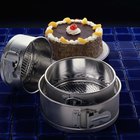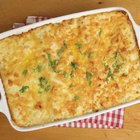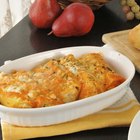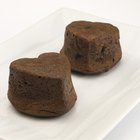
When making lasagna in advance of the date you plan to use it, some small changes to the usual procedure will help you bring a better dish to the table. Lasagna can be prepared as a complete dish or by staging the ingredients ahead of time and assembling the lasagna on the day you plan to serve it. Each method has its benefits, and cooks can choose which best fits their needs.
Staging Ingredients
Instead of making the whole lasagna ahead of time, spare yourself having to prepare the freezer space by creating the ingredients ahead of time, in stages, to be assembled on the day you cook the lasagna. If you prefer homemade sauce or pasta, these can be created a few days to a week in advance and stored. By making the ingredients separately in large batches, you can portion the batches out for recipes during the week or freeze them for later use. This also allows homemade sauce time to develop flavor.
Freezing a Complete Dish
To prepare the dish for freezing, make the recipe as you would normally, but don’t bake the lasagna. If you opt to partially cook the pasta, you may need to bake your pasta a few minutes longer and use a slightly higher temperature to ensure the pasta cooks thoroughly. An additional 15 minutes and up to a 50 degree-Fahrenheit temperature increase is suggested guideline; actual times and temperatures will vary depending on your oven and the size of your dish.
Sauce First
Add sauce to your pan first. While some recipes call for the pasta to go into the pan first and others shun any particular ingredient order, by lining the pan with sauce, you prevent the pasta from sticking to the bottom of the pan as it cooks.
Covering Your Dish
If you cover your pan in cling film, add a layer of baking paper between the lasagna and the cling film. This step is particularly important if you fill your pan to the point that ingredients rise above the rim. This will prevent the covering from freezing and sticking to the top layer of ingredients. This may also help when you’re using a foil cover, but because foil doesn’t tend to settle over the ingredients, it usually presents fewer problems.
Freezer to Oven to Cleanup
Never thaw your lasagna at room temperature. Instead, thaw it in the microwave or in the refrigerator to prevent the growth of harmful bacteria. Use an aluminum baking pan and your lasagna can go directly from the freezer into the oven. You can also save yourself the hassle of cleaning a pan with baked-on sauce, pasta and cheese this way.
If you use a glass pan, take care if transferring it immediately to the freezer. The glass may crack if it is filled with hot ingredients and placed on a cold surface or if you attempt to go from the freezer to the oven without a period of thawing. Consult the manufacturer’s directions for your type of pan for information on how it handles temperature changes. Soak glass pans in warm soapy water for ease of cleaning.
Related Articles

The Cook Time for Lasagna From the ...

The Difference Between No-Boil & ...

How to Make a Layered Lasagna With ...
Can Lasagna Be Preassembled With Egg As ...

How to Make Lasagna Pie in a Springform ...

Casserole Dishes That Feed 12 People

How to Make Homemade Mac & Cheese

How to Freeze Lasagna After Baking It
Can Dry Pasta Be Frozen?

Can I Freeze Unused Cupcake Batter?

Can You Make Chicken Fettuccine Alfredo ...

Freezing a Moussaka
How to Keep Biscuits Warm in a Chafing ...

How to Freeze Manicotti
Do You Have to Cook Lasagna Before ...

What Is a Souffle Dish?

How to Make Dinners Ahead of Time Using ...
How to Make Chicken Pot Pie With Puff ...

What Kind of Dish Can I Cook a ...
How to Freeze Chicken Pot Pie
References
Photo Credits
Jupiterimages/Photos.com/Getty Images